 My newest regular stop for a bit o' interweb reading is A Little Brown Blog, written by a mutt named Carmella. She's the wittiest dog in the blogosphere.
My newest regular stop for a bit o' interweb reading is A Little Brown Blog, written by a mutt named Carmella. She's the wittiest dog in the blogosphere.
Yesterday's post was a whimsical intro to the world of Carmella: somehow combining Facebook, twinkle lights, and "hey-how-are-ya butt sniffs" all in one post.
Excuse me while I go hang a few twinkle lights myself.
Monday, November 30, 2009
A Dog's Eye View of Facebook
Posted at
6:45 PM
1 comments -- view them or add one
![]()
![]()
Categories: Media Goodness
Sunday, November 29, 2009
A Disappointing Riot
 I don't read many books I don't like. I'm not sure if that's because I'm open-minded, or if I've winnowed out the losers before starting.
I don't read many books I don't like. I'm not sure if that's because I'm open-minded, or if I've winnowed out the losers before starting.
There are only a few books I've started and not finished because I couldn't stand them, and I don't think it's ever happened with a young adult novel.
I came close with Walter Dean Myers' recent book, Riot, much to my surprise. While I confess I hadn't read any other books of his, I knew he was a respected writer (winner of the Printz award, and a finalist for the National Book Award and the Newbery), and the book's topic, the Civil War draft riots in New York, is one that's interested me since I was a teenager reading Phyllis Whitney. Plus, I liked its cover.
Despite all that, I almost stopped reading it several times, and only finished it because it was short and I wanted to see if it could somehow redeem itself. The things I disliked:
- I couldn't stand the screenplay structure of the book. It felt forced and artificial, and any film that would result from it would be terrible because it was full of film clichés.
- Despite knowing that Myers is a collector of artifacts of the riots, it seemed to me as though he had no interest in visualizing life in New York, 1863. Perhaps because of the constraints of his chosen screenplay format, there was none of the rich urban detail that can usually be found in historical stories. Myers' "movie" is no Gangs of New York, that's for sure.
- Although it's probably just a conceit for his present-day audience, it really bugged me that the black characters refer to themselves as "black" -- not a term that was in use, generally, in 1863. Colored was the term preferred by polite society at the time, and I found it jarring to repeatedly hear an adjective that wasn't used (at least in the positive sense) for almost a hundred years.
- Finally, there are just too many characters, with no feeling built up for any of them: Irish boys in the mob, Union soldiers in the street, and suddenly Walt Whitman pops in for a breather, spouting poetic insights. At only 154 pages, and with a pretty small number of words per page, it's more of a novella than a novel. But with 28 characters to learn about, the reader never gets much of a chance to care about any of them except 15-year-old Claire.
If it's my skin that makes me unsafe, can I take it off and put it in a drawer until the streets are calm again? If it's my skin that puts me in the sights of murderers, can I change it the way I would change my dress or my apron? Where is this "safe" you're talking about? And if I'm black and you're white and that makes me a target, where is this "family" you're talking about? Where is it, Mum? Where is it? (pages 89-90)I had a hard time, though, believing Claire would have been so protected before the riots that she had no idea how people would perceive her and her parentage. Claire's world, pre-riot, was one where black and white New Yorkers seemed to exist in a race-blind nirvana (working side by side at the colored orphanage, being school chums), only to have the uncivilized Irish destroy it.
My own interest in the draft riots has always left me wondering why the impoverished Irish turned against the city's small black population. It would have made a lot more sense for them to go after the rich, who could buy their way out of the draft by paying $300. It's one of many examples from our history where racial identity undermined class interest, or possibly was manipulated by the powerful to protect themselves. Myers deals with this a bit (the Irish insurrectionists refer to the rich as "swells"), but it's only a minor part of the story.
To check my negative reaction to the book, I set up a little semi-experiment by reading one of Myers' best-known books, Monster. This novel has some things in common with Riot: it's set in New York City with a black teenager for a main character, and it's formatted as a screenplay. That's not as much commonality as it might sound like, though, since it's present-day New York and the teenager is a boy named Steve who's in jail and on trial for felony murder.
The screenplay format makes a lot more sense in Monster, because Myers uses it only part of the time, and it's an organic part of Steve's world view (he'd taken film-making classes before the events of the book began). Plus, Myers mostly confines the screenplay sections to the courtroom scenes, where there isn't much background description required. Most importantly, the first-person notes written by Steve, interspersed with passages from the screenplay, give needed depth and nuance to his character, and are what really makes the book interesting.
Riot, on the other hand, never breaks from the screenplay format. Worse, it's full of heavy-handed visual and even aural direction that would be inappropriate in a screenplay, but that falls far short of what would be possible in a novel. ("LIAM takes a hesitant half-step forward, then inhales deeply. WE HEAR the sound of a low note from a cello that begins to rise in volume" page 123).
As Myers himself wrote in Monster, in the words of Steve's film teacher, Mr. Sawicki: "When you see a filmmaker getting too fancy, you can bet he's worried either about his story or about his ability to tell it" (page 214).
I would love to read the story of Riot again, written as a novel, bringing all of Myers' knowledge of the subject and feeling for his main characters to become the story it should have been.
Posted at
11:09 AM
1 comments -- view them or add one
![]()
![]()
Categories: Books, Reading YA
Saturday, November 28, 2009
(Dis)Ability Symbol

A friend sent me a link to this before and after graphic, from a blog called Graphicology. The newer design is by Brendan Murphy, in association with the Society for Environmental Graphic Design.
I hate to admit that until I saw the suggested redesign, I never realized how much I dislike the dominant disability symbol -- how clunky and static it is, and just what that implies about people with disabilities.
Murphy's design is from 1994. Fifteen years ago! The Graphicology blogger seems to think the design was done in an official capacity, and if so, it should have been disseminated into public spaces pretty widely by now.
I wonder why it hasn't been used?
Posted at
7:39 PM
1 comments -- view them or add one
![]()
![]()
Categories: Part of the Solution
Friday, November 27, 2009
Keeping Abreast of the Recommendations
When I first heard the news that the U.S. Preventive Services Task Force had recommended against teaching women to do breast self exams, and that mammograms become biennial generally and optional for women in their 40s, I have to admit I felt vindicated.
I used to do self-exams, more or less, until I read an article by Dr. Susan Love, a breast cancer specialist, around 20 years ago in the now-defunct feminist newspaper Sojourner. As I recall it, Love made the case that self-exam turns women against their bodies, making us feel as though we are on a search and destroy mission. I recall she said that having a doctor do the exam once a year was sufficient. In reading her current writing on the topic, I see that she clearly makes the point that women should be familiar with their bodies, including their breasts, but that the systematic exam is overrated, whether done by women or their doctors.
Large randomized studies of women taught to do self-exam found no benefit in doing the exam. But there was a 50 percent increase in the number of biopsies done on the women who were doing self-exam. Which led to no decrease in mortality -- only increased stress and cost.
I did get mammograms annually throughout my 40s. I had to have one retaken as a follow-up once. I've known many women who had false positives, sometimes leading to ultrasounds for followup, sometimes to biopsies. I also know multiple women who have had breast cancer, one of whom died from it in her 70s (after ten years of remission from surgery and chemo). One woman was well under 40 at the time; all the others were 50 or over at onset. I don't know the details of how any of their cancers were detected.
According to the most recent research, 1,904 women in their 40s would have to be screened for 10 years (over 19,000 mammograms) to prevent one death. (Contrast this with 1,339 women in their 50s screened for 10 years to prevent one death, and 377 women in their 60s for the same result). And those 1,904 women in their 40s will experience more than 1,000 false positives and the necessary follow-up testing.
Some of the best articles I've read about the Task Force recommendations:
Susan Perry's work on Minn Post. Strongly asserting the evidence-based approach, Perry is a voice of calm and clarity on this contentious issue.
Kevin Sack's news analysis from the New York Times. A balanced view of the controversy.
NPR's Talk of the Nation from Nov. 18, with Drs. Jeffrey Tice and Constance Lehman. A conversation between two doctors, one for and and one against the recommendations.
A New York Times op-ed by Robert Aronowitz, M.D. He reminds us that this controversy is not new, and reviews the past 30-plus years of studies that have indicated the dubious benefits of mammography for women in their 40s. He also supplies a brief history of the medical field's understanding of cancer, and the idea that "catching it early" matters. (Aronowitz is an internist, professor at the University of Pennsylvania, and author of Unnatural History: Breast Cancer and American Society.)
The key thing I take from both the anecdotal testimonials and the well-thought out analyses is that what we need is a better mammogram. As Cynthia Pearson of the National Women's Health Network said (as quoted by Susan Perry on MinnPost):
We’re glad that the [Task Force] has done what they’re supposed to do. They’ve told the truth about what studies have found... But, I’m not at all happy today. Not even to be proven right about things that I took a lot of criticism for saying [in 1993, when the NWHN came out against routine mammograms for women in their 40s]. Rather, I’m outraged. We’ve known for 16 years that mammography screening doesn’t work well for women before menopause, and not at all for women under 40. And at the same time, we’ve known that a significant number of breast cancer cases occur in women under 50. So once we knew mammography wasn’t good enough, the next step was obvious -- we need to find something better.I don't know if digital mammography is the answer.

(Digital image at left; analog at right.)
It sounds as though it may have fewer false negatives (finding 7.9 cancers per thousand, vs. 4. 5 per thousand with film mammography), but I haven't seen mention of studies on whether it affects the rate of false positives. And maybe those 3.4 additional finds per thousand were all relatively benign cancers that wouldn't have led to the woman's death. Who knows.
It's all about the odds, though, and people clearly are bad at understanding risk: 19,000 mammograms and over 1,000 false positives to save one life. The odds are pretty darn bad that the one life would be yours, and in fact, ten times better that you'll think you had life-threatening cancer when you actually didn't. (According to the Wikipedia's summary of the Task Force report, those false postives lead to overdiagnosis of "cancers [that] would never have affected these women in their lifetimes. An estimate of this overdiagnosis is 10 breast cancers diagnosed and unnecessarily treated per life saved when 2,000 women are screened for 10 years.")
But all it takes is one story from a breast cancer survivor in her 40s to make everyone throw logic right out the window. If only we could hear from a few car crash victims killed by head injuries, maybe we'd all be wearing helmets when we drive to work each day.
_________
Update: Dr. Susan Love had a well-written op-ed in the Los Angeles Times, reprinted in the Star Tribune on Nov. 28.
Posted at
2:20 PM
0
comments -- view them or add one
![]()
![]()
Categories: (Mis)Informed
Thursday, November 26, 2009
Now That's a Turkey

What is that, you say? Yes, I know it's hard to tell what's going on in this picture. Here's a hint: It's Thanksgiving today.
It's not just the fact that this photo and the recipe it's based on take something that's basically healthful food (roast turkey) and turn it into a bacon fat travesty.
It's not just the terrible color and unattractiveness of the photo.
No, I think the thing that bugs me the most about this is the woven bacon. (Yes, that's bacon.) Or is it a suit of Samurai armor?
Content originated by the Associated Press, photo by Larry Crowe. From the Pioneer Press, November 19, 2009.
Posted at
5:52 PM
3
comments -- view them or add one
![]()
![]()
Categories: Media Weirdness
Thoughts on Food and the Lack Thereof
 News flash: Twin Cities food shelves weren't able to give out turkeys this year the way they usually do.
News flash: Twin Cities food shelves weren't able to give out turkeys this year the way they usually do.
This may have something to do with the fact that they've had 43 percent more visits in the last six months, without any increase in donations, according to the Star Tribune. So to provide the greatest good to the greatest number, they've eliminated the turkeys in favor of more important staples.
They're also probably mindful of the fact that eliminating the turkeys would get the story of their financial hardship out in front of more potential donors.
So if you're thinking of donating to your local food shelf or a food bank like Second Harvest Heartland, remember: what they can really use is money.
It drives me crazy that people go to supermarkets and buy food to donate to food shelves, because the food shelves and food banks could have gotten over three times as much food for the same money if those well-intentioned people had just donated the money instead. (I'm sure it varies, but for instance, Second Harvest Heartland says they leverage $9 worth of food from every $1 donated.)
I guess the idea is that people want their children to participate in the purchasing and giving of the food, and I can understand that. But isn't the idea to get food to people who need it, not just create an object lesson for your own well-fed child?
This reminds me of another well-known Twin Cities organization. This group, which is overtly Christian, organizes volunteers from churches and companies to come in and help mix up portions of vitamin-laced dried food. My own daughter went to a birthday party once to help bag the stuff.
After the packages are ready to go, they're shipped to orphanages and "feeding centers" around the world. (Don't get me going on that term "feeding center" -- doesn't it sound like a place where animals are fed?) Mixed with water, it makes a nutritious, if bland, food source. I'm sure the people who get it are happy to have it, compared with the alternative (malnutrition and starvation).
However, I was told by a reputable source that the organization was advised nearly a decade ago that if they automated their food-mixing and packaging process (and therefore decreased the need for volunteer labor), they would be able to greatly increase the amount they could create on the same budget.
You'd think they would have jumped at the chance. But no. They rejected it because they believed that involving volunteers was more important to their mission than feeding the greatest number of people.
If feeding the most people isn't their primary mission, perhaps they should change their name from one that talks about feeding hungry children to something about assuaging the consciences of prosperous American Christians.
What would Jesus do? Somehow I think he'd be a bit more utilitarian.
Posted at
9:04 AM
1 comments -- view them or add one
![]()
![]()
Categories: Afflicting the Comfortable
Wednesday, November 25, 2009
Some Final Wisconsin Miscellanea

I usually consider the spelling of children to be off limits for public review, but I couldn't resist this sign with its attempted correction of Garrd to Gaurd. (Seen in Appleton.)
When you have a small business in a town with a name like Rudolph, you're almost obligated to name your business this way, I suppose.
Posted at
4:22 PM
0
comments -- view them or add one
![]()
![]()
Categories: Drive-by Shooting
How Bad Can One Sentence Be?
Check out this sentence, from a question recently fielded in the Outside Consultant column in the Star Tribune's business section:
I design and sell inspirational jewelry for mothers and women battling weight loss, infertility and cancer on my website.
I believe that's what's called a dangling modifier. (Unless the writer's website includes a new web app with startling medicinal powers.)
And according to my recollection of set theory and knowledge of human genders, I think the set "women" includes the set "mothers."
No, wait a minute, it's worse than I thought. I just checked the questioner's website and now realize she meant that the jewelry is for mothers generally and also for women battling the aforementioned conditions. I didn't get that from the sentence at all.
Are there any editors left at the Strib?
Posted at
3:33 PM
2
comments -- view them or add one
![]()
![]()
Categories: Honey--Get Me Rewrite
Tuesday, November 24, 2009
Holiday on Stage
I'm a Twin Cities transplant, so I have no attachment to the Guthrie's "venerable" production of A Christmas Carol. In fact, I haven't attended many Christmas shows at all in my 23 years here.
That said, here are the upcoming holiday shows I'll be watching for and (I hope) attending:
For the first time, Commedia Beauregard is staging its Klingon Christmas Carol for multiple shows. Starting on Friday, November 27, the show will run through December 13 at the Mixed Blood Theater in Minneapolis's West Bank neighborhood. Tickets are $18 for adults, $14 for students and seniors. (The show on Monday, December 7, is $5 off if you bring one can of food to donate; bring three and you'll get in free.) Here's my past post on this fun show.
Jacob Marley's Christmas Carol, starring Jim Lichtscheidl, December 3 - 20 at Park Square Theatre. Tickets are $36, or $15 for people under 30. I know, I know, another Christmas Carol rendition -- but Jim Lichtscheidl is amazing to watch, so I want to see it anyway (and I'll still have the energy to watch Mr. Magoo's A Christmas Carol). I saw Lichtscheidl play Seymour in Ten Thousand Things' Little Shop of Horrors, and it was among the top three performances of my life.
Switching gears, the last show I'm thinking about is All Is Calm: The Christmas Truce of 1914 at the downtown Pantages Theater. I've been a sucker for this story since I first heard the John McKutcheon's song "Christmas in the Trenches." In case you don't know it, it's a true story from the Western Front during World War I. On Christmas Eve, German and British soldiers sang carols and played soccer in the No Man’s Land between their trenches. The choral group Cantus, Theater Latté Da and Hennepin Theatre Trust staged it for the first time last year (I missed it) and it's back again this year December 17 - 20. Tickets $27.50 - $35.00
Posted at
4:57 PM
2
comments -- view them or add one
![]()
![]()
Categories: Out and About
Monday, November 23, 2009
The Globe Collection at Hamilton
Why go to Wisconsin for a weekend in late November?
For the Wayzgoose Weekend at one of my all-time favorites, the Hamilton Wood Type Museum in Two Rivers, of course. (Past posts on the museum.)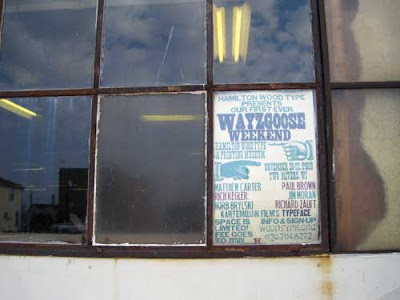
A primary reason for the event was the unveiling of a new wood type font by Matthew Carter, one of the most prominent living type designers (best known by the teeming masses for the common web fonts Verdana and Georgia, but also the phonebook font Bell Centennial, among many others).
Carter's new typeface was proof printed for the first time during the Wayzgoose. It combines two separate fonts, a positive and a negative, which can be printed together in two colors. Everyone at the Wayzgoose got to print from the letters on their choice of paper color.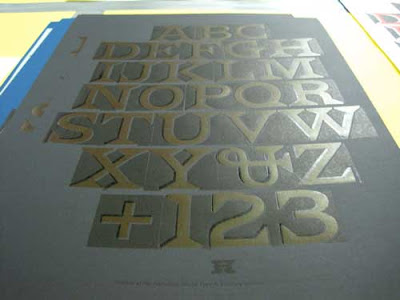
During the course of the Wayzgoose, it was announced that the typeface would be named Van Lanen, in honor of the museum's founder, James Van Lanen.
One of the weekend sessions highlighted the museum's Globe Collection, which was acquired from the Globe Printing Company of Chicago.
Jim Moran, the museum's technical director, showed a group of the cuts, which were used to print posters for movies, stage shows, car racing, political parties, and circuses. The collection also includes a large number of grocery store cuts, and in general represents a unique glimpse of American commercial culture in the 20th century.
The Globe company stopped using its vast number of illustration cuts and wood type fonts in 1980. Everything was packed into large boxes or put onto pallets in layers, and then loaded into a semi trailer. Which then sat outside through 25 Chicago summers and winters.
By the time the collection was donated to the Hamilton museum, the floor of the trailer was deteriorating, making it impossible to use a pallet jack to move the boxes and pallets, so it had to be unloaded by hand. If the weather could do that to a semi, imagine what it could do the printing materials.
There are still dozens of boxes and pallets waiting to be unpacked at the museum, but a lot of progress has been made.
The plates are generally wood with a vinyl layer glued to it. The vinyl was then cut away to create a raised printing surface. This is the red plate...
...for the Asylum of Horrors stage show poster.
This is the black plate, cut from wood, for a stock car racing poster. The squares at bottom were meant for local dates and locations.
Most of the posters were two or three colors. Sometimes the collection includes all the plates; sometimes it doesn't. Maybe the others are in one of the boxes waiting to be unpacked.
Even when they're all present, one may be in such bad condition that it can't be printed.
In some cases, it's clear which ink color should be used to print each plate, while at other times, it's not, requiring some trial and error work.
The orange plate for this striking Halloween poster.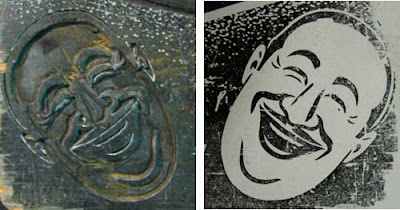
Robert Benchley, carved in wood, from the poster for the movie The Hired Wife.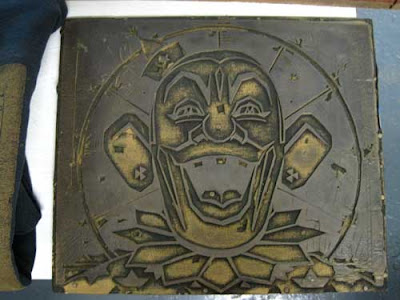
Because some of the plates are warped from lack of temperature control, they sometimes can be printed best on fabric instead of paper.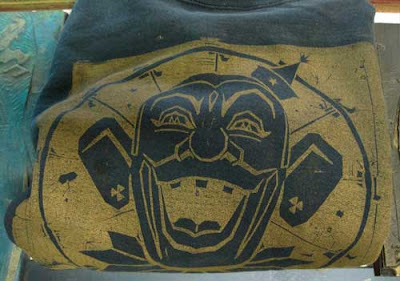
Like this evil clown, which makes an excellent sweatshirt!
Some of the posters made from the Globe Collection so far are for sale on the museum's website.
For more on the Hamilton Wood Type Museum, see Nick Sherman's Woodtyper blog or the Flickr stream from the Wayzgoose Weekend.
Posted at
6:46 PM
2
comments -- view them or add one
![]()
![]()
Categories: Road Trip
Sunday, November 22, 2009
Shel Shock

Thanks to Peter Sieruta over at Collecting Children's Books, I just found out that the words to Johnny Cash's song "A Boy Named Sue" were written by Shel Silverstein.
Silverstein also wrote the lyrics to that silly song "The Unicorn" by the Irish Rovers ("Some humpty backed camels and your chimpanzees, Some cats and rats and elephants...") as well as the one called "On the Cover of the Rolling Stone" by Dr. Hook and the Medicine Show.
Sheesh. It's amazing how many pieces of trivia have never found their way into my head. How can it be so full when important facts like these are not included?
______
Here's one of my favorite earlier posts that's tangentially related to "A Boy Named Sue."
Posted at
9:57 PM
1 comments -- view them or add one
![]()
![]()
Categories: Facts I Never Knew, Music
Rocks and Glass at the Rudolph Grotto

Each time I traverse Wisconsin, I discover another folk art environment I didn't know about. This time it was the Rudolph Grotto Garden in Rudolph, not too far west of Steven's Point.
It was built beginning in 1928 by the parish priest. It includes the stations of the cross, which in late November were adorned with flowering cabbages.
Much of the grotto is rough red stone shaped into mounds, bridges and other outcroppings. My favorite parts were the tile work here and there.
This memorial mosaic combines tile and seashells.
Detail of the cross shape on the memorial.
Crazy glass embedded into the stone.
This sundial is part way up the large stone mound that houses the Grotto's Wonder Cave (which was closed for the season).
More tile detail combined with the red rocks.
From the looks of the plant labels lovingly maintained throughout the garden, it appears as though the grotto would be an even better place to visit during the growing season.
(See my past post about the Glass Grotto in Cataract, Wisconsin.)
Posted at
12:21 AM
3
comments -- view them or add one
![]()
![]()
Saturday, November 21, 2009
The Fair State of Wisconsin

I was driving through Wisconsin (Neillsville, to be exact) and what did I see but this vision of yellow-roofed modernity. It's a radio station and cheese gift shop, and who can resist that? So we had to stop and see what it was.
Next to the parking lot was Chatty Belle, the World's Largest Talking Cow. (Probably made in Sparta, Wisconsin, at FAST Signs.)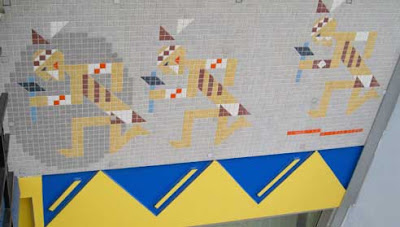
Approaching the door, I saw this tile motif, wrapping the building in dubious taste.
Inside, the cheese shop featured some unusual versions of the typical Wisconsin cheesehead hat.
 I got a good look at the ceiling over the gift shop.
I got a good look at the ceiling over the gift shop.
And that was about it.
But wait! I noticed there were stairs to a lower level, and over the stairs a sign that said World's Fair Exhibit. That sounded interesting, so I descended.
It turned out that this building had been the Wisconsin pavilion at the 1964 New York World's Fair! It served 15,000 cattleman's beef dinners a day, and had the world's largest cheese on display.
The exhibit contained dozens of pieces of Fair memorabilia. (I attended the Fair when I was 4 years old; I'm told I was fascinated with the trash cans.)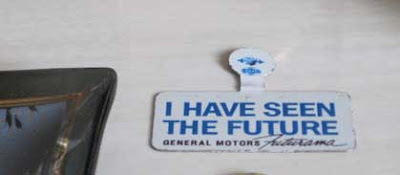
I don't think we saw the futuristic General Motors pavilion, but we did get to see the Ford Pavilion. It included dioramas of cavemen and witches and other ominous things, and I tried to climb out of the car, which was a convertible.
One of the things I remember liking the best was Sinclair Oil's Dinoland. The Neillsville exhibit included this brochure showing a map of Dinoland, and six of the wax dinosaurs you could buy there. (The green brontosaurus was my souvenir of the Fair, and I had it for a long time.)
This was one of the best roadside finds -- at least, the best unplanned one. Who knew this was plunked in the middle of Wisconsin on highway 10?
Posted at
12:02 AM
1 comments -- view them or add one
![]()
![]()
Categories: Road Trip
Friday, November 20, 2009
Little House Made from the Big Woods

Last week, Minnesota Public Radio's Dan Gunderson had a cool story about a guy who's building a house made out of cord wood up on the White Earth reservation.
In this type of house, typical 16"-long firewood is stacked so the wall is as deep as the wood is long. The gaps between the pieces are filled with mortar.
No other insulation is needed, and it makes for an attractive, energy-efficient home. The labor required can be done as sweat equity from the homeowner, too, since it doesn't require a lot of skill. A 1,000-square foot home can be completed by a builder for $90,000; with owner labor, as low as $45,000.
Check out the full story and a short slideshow on the MPR site.
Posted at
5:24 PM
0
comments -- view them or add one
![]()
![]()
Categories: Part of the Solution
Thursday, November 19, 2009
Fun with Facebook
Facebook's new Live Feed insists on reporting each time one of my friends becomes a fan of some cause. And, being the economical service that it is, if two friends join the same cause, Facebook combines their announcements together... almost like a wedding announcement.
This leads to some odd juxtapositions:
The first one joined up my 13-year-old nephew with a (male) college friend. Both of them are grumpy about all the emails they get from Facebook.
The second combined a graduate school (woman) friend with the same 13-year-old nephew. They both enjoy stomping on crunchy leaves.
Thanks, Facebook!
Posted at
4:14 PM
0
comments -- view them or add one
![]()
![]()
Categories: Life in the Age of the Interweb
Wednesday, November 18, 2009
Silent Screams
I got this in my email yesterday... it was basically a spam, I guess:
Believe it or not, these folks are selling voice talent.
Does that image make you want to hire them? Or run away from the Night of the Living Dummies?
And what's with the Terminator claw of death dangling over their bald pates?
I think somebody needs to hire a real designer.
Posted at
5:10 PM
0
comments -- view them or add one
![]()
![]()
Categories: Media Weirdness
Tuesday, November 17, 2009
What It Takes to Steal Cars
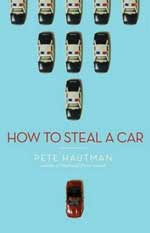 Kelleigh Monahan, the main character in Pete Hautman's young adult novel How to Steal a Car, is every parent's nightmare.
Kelleigh Monahan, the main character in Pete Hautman's young adult novel How to Steal a Car, is every parent's nightmare.
She's the kind of girl who's never gotten into trouble, who has good grades and long-term friendships, who believes her mother is a truly nice person and whose father has always been gruffly affectionate. They eat a family dinner together every night. She's even reading Moby Dick more or less of her own free will over summer break, for pete's sake.
Clearly, Kelleigh's brain has its share of what psychologists call "executive function" -- according to Po Bronson and Ashley Merryman's fascinating book Nurture Shock, "Among these executive functions are the orchestration of thoughts to fulfill a goal, prediction of outcomes, and perceiving consequences of actions" (page 34).
Despite all this, when presented with an opportunity to steal a car after she sees a man drops his keys, instead of returning them, 15-year-old Kelleigh and her learner's permit take the car on a sedate joy ride.
Why? The first-person narrative portrays it as coincidental, but the act of keeping the guy's keys in the first place was not a coincidence. All we get about her motivation for that act is "I opened my mouth to tell him he'd dropped his keys, but for some reason I didn't" (pages 2-3). When her friend asks her why she's not returning them, Kelleigh replies, "I'm sure he's got another set" (page 3).
Soon after, she reviews all the reasons she shouldn't have taken the car:
"...imagining myself getting arrested and thrown in a jail cell with a bunch of skanky prostitutes and drug addicts and baby-killers... I thought about my parents looking at me through the bars of my cell. My dad saying, Why on earth would you do such a stupid thing?Kelleigh's narration reveals a girl who doesn't want to be pigeon-holed, and who represses her feelings until they come out in unexpected way. As she puts it, "I am such a total bitch inside for some reason, even though mostly I don't show it. But the things I think -- sometimes I'm surprised they don't just claw their way out through my skin" (pages 83-84).
I would tell him it had nothing to do with lack of intelligence.
You've got your whole life ahead of you!
Yeah, Dad, but it was one of those living-in-the-moment things.
The thing he would never understand was that it only had to make sense for about one decision-making nanosecond.... Anyway, we got away with it. Because for every time some kid like me pays the price for doing something incredibly stupid, there are a thousand times she gets away with it. (pages 18-19)
After the first theft, Kelleigh has felt the adrenalin rush of the act, and a feedback loop begins. As she says, "There is no real difference between scared and excited. Think roller coaster. Think first kiss. Think stealing a car" (page 33). She does it again because a friend asks her to, then again to give another friend a ride, then finds out she can make some money by selling the cars, with the help of an experienced car thief named Deke.
She clearly knows what the right thing to do is and does not do it. And that's one of the things she likes about it:
There was no fuzziness about what Deke and I were doing. It was immoral, illegal, risky, and entertaining.... we each had a job to do, and until the job was over we were defined by what we did. What we had to do. I think this is why guys like football, and why they join the army, because as long as you are playing the game or following orders you do not have to figure out who you really are (pages 116-117).Finally, Kelleigh almost gets caught in the midst of a theft (only escaping because she uses the car to assault the car's owner), and the reader (at least this reader) is having trouble maintaining any kind of sympathy for her. She has no remorse for almost injuring or killing the man ("what I felt then...was...anger and frustration that he had gotten in my way, that he had tried to interfere" page 150). When questioned by a cop, she lies smoothly and convincingly. She's turning into a polished sociopath.
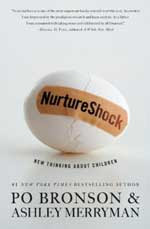 All this makes for a chilling parental read, because Kelleigh could be your own seemingly well-adjusted teenager: she shows no outward sign of her inner amorality.
All this makes for a chilling parental read, because Kelleigh could be your own seemingly well-adjusted teenager: she shows no outward sign of her inner amorality.Hautman's story fits right in with Nurture Shock's chapter on the science of teen rebellion. Researchers, Bronson and Merryman write, "found that teen brains can't get pleasure out of doing things that are only mildly or moderately rewarding." While young children find any type of reward thrilling, and adults respond to rewards with predictable increases as the reward increases, teens do not respond except to the biggest reward of all, "essentially the same response curve of a seasoned drug addict. Their reward center cannot be stimulated by low doses -- they need the big jolt to get pleasure" (page 144).
And not only that, but when the reward center in teens was activated, the prefontal cortex (home of that executive function I mentioned earlier) showed less response: "it was as if the pleasure response was 'hijacking' the prefrontal cortex. At the very moment when experiencing an emotionally charged excitement, the teen's brain is handicapped in its ability to gauge risk and foresee consequences" (page 144).
I couldn't help wondering if Hautman was aware of this research, because his book exemplifies it so well. And whether he intended the book's open ending to make a statement, and if so, what it was. According to a story from Minnesota Public Radio,
Hautman says when half the adult reviewers are upset by the novel [as in the case of How to Steal], then he's probably hit the right note for his teen audience.I think it's appropriately uncomfortable that the book is left open-ended, with an unrepentant, unpunished Kelleigh. But at the same time, I have to reassure myself it's silly to wonder if her malfunctioning executive function might be contagious just from reading about it.
"I don't offer a moral coda at the end. And adults, especially adults reading teen books, they want that," said Hautman. "They want to think that this is somehow a useful tool for their child. But kids should get a lot more credit than they do for being able to figure things out."
__________
An afterthought: Here's one final quote from How to Steal a Car that shows Hautman's gift for writing: "Once you're a teenager, adults stop talking about the crazy stuff they used to do, and they start acting as if they were raised by the Amish" (page 54).
__________
A second afterthought: I just discovered Kirkus Review's Dec. 1 write up of Nurture Shock, in which they recommend that writers of children's literature refer to Nurture Shock in the interest of knowing their audience better. And maybe even for some story ideas.
Posted at
7:33 PM
1 comments -- view them or add one
![]()
![]()
Categories: Books, Reading YA
Monday, November 16, 2009
Happy Birthday, Kerlan Collection!
Yesterday was the Kerlan Collection's 60th anniversary celebration, and to mark the occasion, the U of M Libraries hosted a talk by Leonard Marcus, literary historian and children's literature critic.
Marcus spoke about the kinds of things a researcher finds in collections like the Kerlan. Of course, it made me want to drop everything and go do some research myself!
He has published a variety of books, from picture books to interviews with writers to his own research on literary figures. A few paraphrased more-or-less quotes I particularly liked:
"Children's books tell the story of changing culture. What a society cares about is revealed by the books it chooses to give and not give to its children."
"Children's book illustrations are the most distilled forms of artwork of any kind."
Marcus spent much of the talk relaying details about the sleuthing involved in creating his book Margaret Wise Brown: Awakened by the Moon. It all started when he stumbled across a copy of MWB's book Goodnight Moon in the early 1980s (the book wasn't such a widely known classic at the time... I never read it as a child, did you?). Inspired, Marcus set out to learn more about MWB. He placed an author's inquiry in the New York Review of Books and got one serious reply, from a man who knew Goodnight Moon's illustrator Clement Hurd. This led to a meeting with Hurd, and the years-long process of researching the book was begun.
It all started when he stumbled across a copy of MWB's book Goodnight Moon in the early 1980s (the book wasn't such a widely known classic at the time... I never read it as a child, did you?). Inspired, Marcus set out to learn more about MWB. He placed an author's inquiry in the New York Review of Books and got one serious reply, from a man who knew Goodnight Moon's illustrator Clement Hurd. This led to a meeting with Hurd, and the years-long process of researching the book was begun.
MWB had worked with several talented illustrators in addition to Hurd, including Leonard Weisgard (The Noisy Book, The Little Island) and Garth Williams (The Little Fur Family, Sailor Dog). Marcus went to Denmark to meet Weisgard, who told him he thought the photographer who had taken some of the few published photos of MWB was named Canaga.
Returning to New York, Marcus had no luck finding any reference to a photographer by that name until he happened by a used bookstore one day. In the window was a book about women photographers, and the name Consuelo Canaga was on the cover. It turned out the Brooklyn Museum had some negatives of hers, so Marcus spent a day looking through three boxes (using a bare light bulb instead of a lightbox). At the end of the third box, he found the negatives of her photos of MWB, and was able to publish them in his book.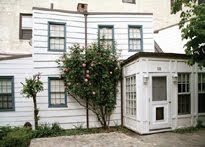 Another anecdote Marcus told involved a little white house where MWB had lived (or possibly used as a writing studio). Located in Greenwich Village, the house is tiny and ramshackle, an almost magical place -- perfect for MWB's tendency to mix fantasy and reality together in her presentation of self. The house had originally been built as a shepherd's cottage on the Upper East Side around 1810. The city grew up around it (Marcus made the point that it was much like a real-life version of Virginia Lee Burton's Little House), until it was moved to the very edge of Greenwich Village. It remains there today, at 122 Charles Street.
Another anecdote Marcus told involved a little white house where MWB had lived (or possibly used as a writing studio). Located in Greenwich Village, the house is tiny and ramshackle, an almost magical place -- perfect for MWB's tendency to mix fantasy and reality together in her presentation of self. The house had originally been built as a shepherd's cottage on the Upper East Side around 1810. The city grew up around it (Marcus made the point that it was much like a real-life version of Virginia Lee Burton's Little House), until it was moved to the very edge of Greenwich Village. It remains there today, at 122 Charles Street.
Having not read Marcus's book (though I hope to soon!), one of the things I found most interesting about MWB and her work was that it was very much based in the philosophy of progressive education, and that it was considered quite controversial at the time. She studied at the Bank Street College of Education in the 1930s, a protege of its founder Lucy Sprague Mitchell. As MWB's publishing career advanced, she enjoyed sparring with librarians (such as Anne Carroll Moore) who disagreed with the progressive education approach and wanted to maintain influence over what was published and available in libraries. According to Marcus, Good Night Moon didn't get into the New York Public Library collection until 1973 (it was originally published in 1947).
Margaret Wise Brown died much too young at the age of 42 while in Nice, France (1952). After an operation to remove an ovarian cyst, she was confined to bed, as was common hospital practice at the time, which caused clots to form in her extremities. She died from an embolism. At the time, it was reported that the surgery had been to remove her appendix, but Marcus's research found the truth, which had been euphemized because it was a "female" health problem.
After the talk ended, everyone went to the Anderson Library building, home of the Kerlan Collection, for cake and a look at the exhibit set up to commemorate the anniversary. Original artworks by Wanda Gag, Louis Slobodkin, Ted Rand and many others are on display.
A few favorites of mine shared this display -- Caps for Sale by Esphyr Slobodkina and Ferdinand the Bull by Munro Leaf (illustrated by Robert Lawson).
Happy 60th birthday! I hope to visit you soon.
Posted at
6:16 PM
1 comments -- view them or add one
![]()
![]()
Categories: Books, Reading YA
Sunday, November 15, 2009
Give to the Max for Minnesota Nonprofits This Tuesday
 If you're in Minnesota, you'd have to be hiding under a rock to have missed the announcement of Give to the Max day this Tuesday, Nov. 17. I've received letters, emails and Facebook messages from nonprofit organizations I've supported in the past, encouraging me to give on Tuesday.
If you're in Minnesota, you'd have to be hiding under a rock to have missed the announcement of Give to the Max day this Tuesday, Nov. 17. I've received letters, emails and Facebook messages from nonprofit organizations I've supported in the past, encouraging me to give on Tuesday.
How it works: A new website called GiveMN.org provides each Minnesota nonprofit group a way to receive donations online. This may not seem like a big deal, but getting donations set up on the web is a major hassle and expense for nonprofits.
On any day of the week, donations made through GiveMN are handed over to the donor's intended organization without taking a percentage of the donation for handling or transaction fees. This is a great reason to use GiveMN for making donations in general, since web-based donations usually have 3 - 10 percent deducted off the top before the money ever gets to the charity. On GiveMN, these fees are paid by the sponsoring foundations.
But Give to the Max day is even better -- the foundations that set up GiveMN are matching every dollar donated with a 50 cent donation. So if you send your favorite charity $100, they'll actually receive $150.
Personally, I'm planning to shift my usual late-December donations to Give to the Max day, so my causes get more out of it.
I know this sounds like a press release, but it's not. I want to make sure everyone knows that this is a chance to get more money to organizations at a time when they really need it, and -- as they say during the public radio pledge drives -- make your donation dollars go even farther.
Note: There is a $500,000 limit on the match, but it's not first-come, first-served. So if people give over a million dollars during the 24-hour period starting at 8:00 a.m. on Tuesday and ending 7:59 a.m. on Wednesday, GiveMN will split the $500,000 in proportion to how much each charity received in donations that day. If donors give under a million dollars, the charities will receive more than 50 cents on the dollar.
Posted at
10:51 AM
0
comments -- view them or add one
![]()
![]()
Categories: Part of the Solution
Saturday, November 14, 2009
The Magic Forest

I've never been to The Magic Forest, an old-fashioned theme-park-qua-folk-art-installation in the Adirondack area of New York state.
But I always wanted to go to places like it as a child. I have a vague recollection that my older sisters got to go there during a trip when Daughter Number Four and I were too young and had to stay with grandma. (Note to parents of multiple young children: If you're planning a trip and considering taking the older kids while leaving the younger, those whiny left-behinders will grieve their deprivation for the rest of their lives. And grow up to write a blog post about it.)
Now I feel almost as if I've been there. Sweet Juniper, a heckuva blog out of Detroit, visited the Forest this past summer and posted a wonderful photo gallery of everything from The Snow Clown to Marilyn Manson's senior portrait.
Not to mention, of course, Lightning, the Nation's Only Diving Horse. I wonder what PETA thinks about that.
Posted at
2:45 PM
3
comments -- view them or add one
![]()
![]()
Categories: Art

